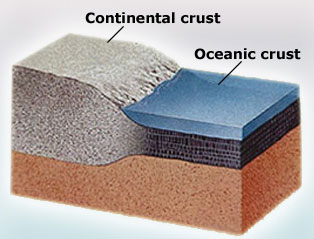Tectonic plates are pieces of the lithosphere that move around on top of the asthenosphere. You can think of the lithosphere as a giant jigsaw puzzle. The map below shows the major tectonic plates.
![]() Scroll over each number to see the name of the plate.
Scroll over each number to see the name of the plate.
Notice that each tectonic plate fits with the other tectonic plates that surround it and that not all tectonic plates are the same in terms of size, shape, and depth. Some plates are very large, such as the North American plate, while other plates, such as the Cocos plate, are very small.
Another difference in the plates is that some contain both continental and oceanic crust while others contain only oceanic crust.

Source: Continental and Oceanic Crust, USGS
The chart below describes the differences in the two types of crust.
Continental Crust |
Oceanic Crust |
|
|
The North American plate is an example of a tectonic plate that contains both types of crust, while the Cocos plate only contains oceanic crust. Notice that the plates are not divided along continental lines. The North American plate contains the North American continent as well as Greenland, half of Iceland, and part of Eurasia.